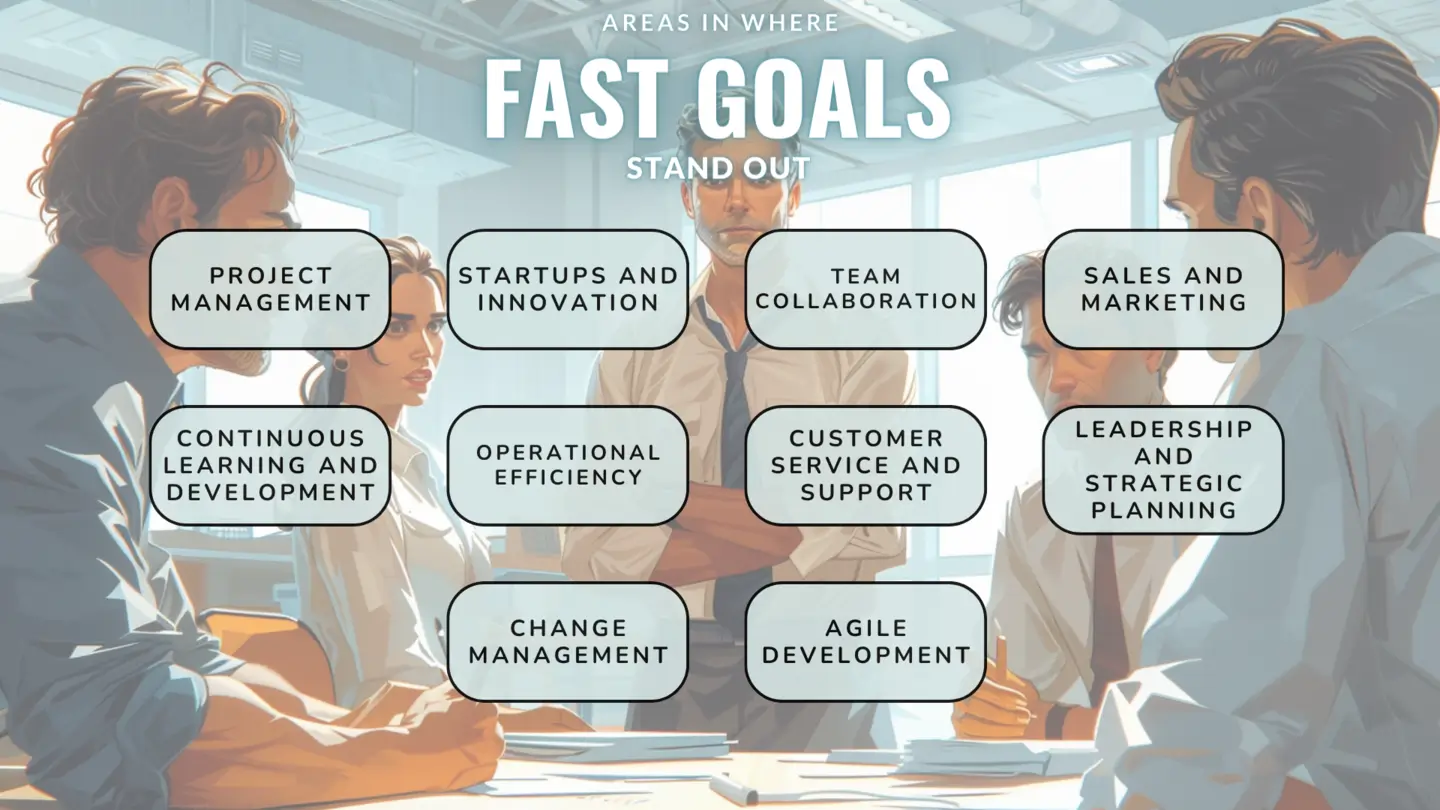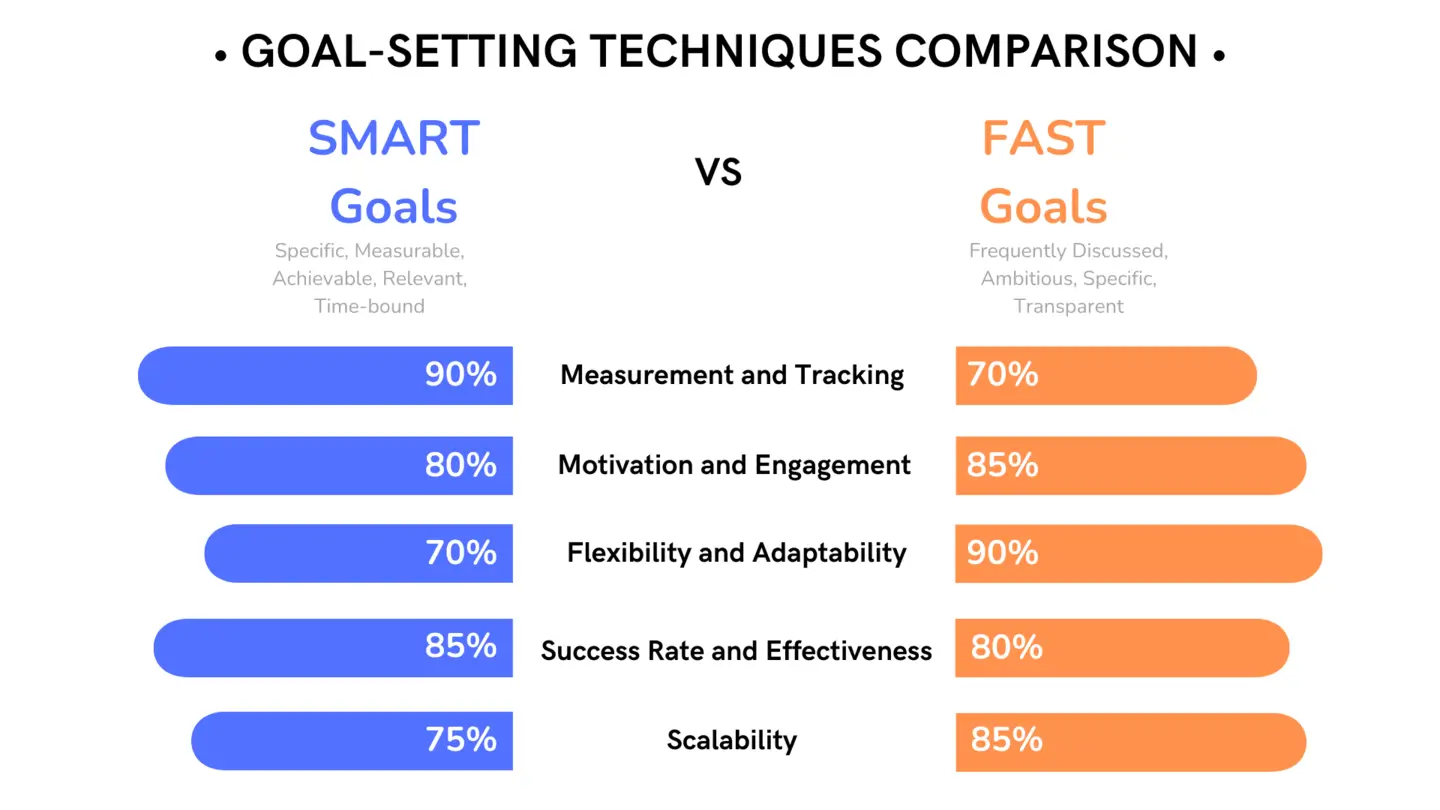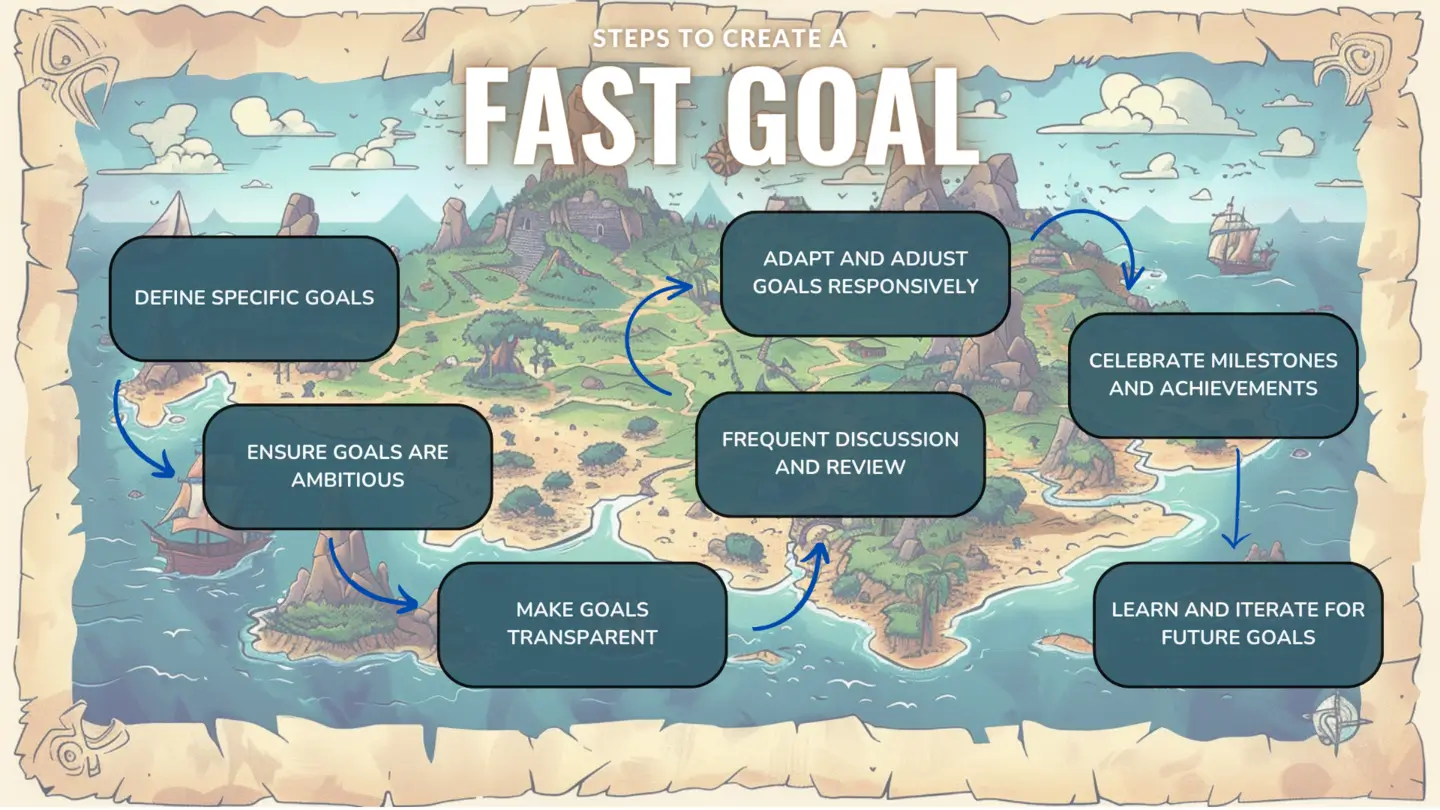Have you ever felt stuck on a goal, unsure how to make real progress? Many goal-setting methods can feel rigid or lack the spark to keep you motivated.
Setting goals is a crucial part of personal development, but traditional approaches might not always provide the flexibility and dynamism needed nowadays.
FAST goals offer an alternative approach that emphasizes frequent communication, ambitious targets, and clear objectives. This method can inject excitement and adaptability into your goal-setting process, potentially leading to greater success.
The Basics of FAST Goals
Ready to try a new approach to goal-setting? FAST goals prioritize clear communication, ambitious targets, and adaptability.

Let’s take a closer look at what FAST goals are all about!
What are FAST Goals
FAST goals offer an alternative framework to traditional goal-setting methods, focused on agility and clear communication. Here’s a breakdown of what each letter in the acronym represents:
- Frequently Discussed: FAST goals aren’t something you set and forget. They’re designed to be talked about often, keeping them top-of-mind and allowing for adjustments as needed.
- Ambitious: This method encourages you to dream big! FAST goals should push you slightly beyond your comfort zone, fostering growth and preventing stagnation.
- Specific: Vague goals lead to vague results. FAST goals are well-defined, outlining exactly what you want to achieve and how you’ll measure success.
- Transparent: Everyone involved (whether that’s your team, a mentor, or yourself) should be aware of your FAST goals. This openness promotes collaboration, support, and accountability.
The FAST method isn’t simply a list of principles; it’s a shift in how you think about the entire goal-setting and achievement process.
"The way to get started is to quit talking and begin doing."
 Walt Disney
Walt Disney Importance of FAST Goals
Here are some of the key benefits this method offers:
- Boosted Motivation: The ambitious nature of FAST goals coupled with regular check-ins can create a sense of excitement and keep you driven to succeed.
- Sharper Focus: With specific goals and frequent discussion, you remain laser-focused on your targets, reducing wasted time and effort.
- Enhanced Adaptability: The emphasis on communication and transparency means FAST goals can easily be adjusted in response to changing circumstances.
- Greater Accountability: Sharing your goals adds a layer of responsibility, helping reduce procrastination and encouraging you to follow through.
- Team Alignment: In group settings, FAST goals increase transparency and help ensure everyone is working towards shared objectives.
FAST goals are designed to promote a growth mindset and address common obstacles that can derail traditional goal setting.
Research shows that 14% of people with goals are 10 times more successful than those without goals. (Source: HBR)
Areas in where FAST Goals Stand Out
FAST goals offer particular advantages in a few key situations:
- Evolving Projects: When requirements or circumstances are likely to shift, the in-built flexibility of FAST goals allows you to adapt without abandoning the overall objective.
- Focus on Growth and Learning: If development and improvement are core goals alongside a defined outcome, FAST goals encourage regular self-assessment and prioritize progress over simply hitting a target.
- Team Collaboration: Transparent communication and the potential for frequent check-ins foster collaboration and knowledge-sharing, benefitting team-oriented goals.
- Maintaining Motivation: The emphasis on ambitious targets and open communication keeps you engaged, which is crucial for long-term or challenging goals.

Advantages and Disadvantages of FAST Goals
Like any goal-setting framework, FAST goals have both strengths and potential drawbacks. To decide if this approach is right for you, it’s important to have a balanced perspective.
Let’s explore some of the most notable pros and cons associated with FAST goals.
Frequent Discussion
A hallmark of the FAST goal method is the focus on open communication and regular check-ins. This core principle offers both potential benefits and a few possible drawbacks.
Let’s take a look at both sides:
Advantages- Keeps Goals Top-of-Mind: Frequent discussions ensure your goals stay fresh and don’t get lost in the shuffle. Regularly revisiting your goals reinforces your commitment and keeps them at the forefront of your thoughts and actions.
- Promotes Accountability: Knowing you’ll be discussing your progress with others can be a powerful motivator. This added layer of accountability can help you stay on track and overcome procrastination.
- Allows for Course Correction: Life throws curveballs! Frequent communication allows you to adapt your goals as needed, ensuring they remain relevant and achievable in light of changing circumstances.
- Fosters Support and Collaboration: Sharing your goals with a supportive network can be incredibly valuable. Open communication allows others to offer encouragement, resources, or even join you in your pursuit, making the journey more engaging and potentially doubling your success rate.
DisadvantagesStudies show consistent communication and social support are crucial for overcoming obstacles: 95% of people who had a goal-buddy reported they achieved their goals. (Source: Observer)
- Can Feel Like Micromanagement: For some, regular check-ins might feel overly intrusive or controlling. It’s important to establish a frequency and format for discussions that feels comfortable and supportive for everyone involved.
- May Require Scheduling Extra Meetings: Depending on your workload and schedule, finding time for frequent goal discussions might require additional planning and meeting scheduling.
- Can Be Disruptive if Goals Change Frequently: While adaptability is a strength, goals shouldn’t be so fluid that they lose all direction. Finding a balance between open discussion and maintaining a clear focus is key.
- Relies on Having a Supportive Network: The benefits of open communication hinge on having a reliable and encouraging support network. If you lack this in your personal or professional life, you may need to invest extra effort in building those relationships to fully benefit from this aspect of FAST goals.
"The art of communication is the language of leadership."
 James Humes
James Humes Ambitious Targets
The FAST goal approach encourages you to reach high and set goals that push you beyond your immediate comfort zone.
Here’s a look at both the benefits and possible challenges of this aspect:
Advantages- Drives Growth and Development: Aiming high forces you to step outside the familiar, fostering personal and professional growth. It challenges you to improve your skills, resourcefulness, and overall mindset.
- Increased Motivation: Ambitious goals can ignite a sense of excitement and possibility. They make the pursuit more compelling, giving you something truly inspiring to work towards.
- Potential for Greater Accomplishments: While reaching an ambitious goal isn’t guaranteed, setting your sights high expands the realm of what you deem possible. You might surprise yourself and achieve far more than originally anticipated.
- Risk of Discouragement: Setting excessively ambitious goals can backfire if they feel overwhelming or unattainable. It’s crucial to find a balance between stretch goals and a realistic shot at achievement to avoid demoralization.
- Need for Careful Planning: Ambitious goals require extra thought and often additional resources. To set yourself up for success, you’ll need to break down the goal into manageable steps and create a sound strategy.
- May Require Mindset Shift: If you’re used to playing it safe, embracing ambitious targets might require a shift in your perspective. This means getting comfortable with potential discomfort and learning to view setbacks as stepping stones rather than failures.

Specificity
FAST goals emphasize clarity and precision. This means avoiding vague aspirations and instead crafting objectives that are well-defined and measurable.
Let’s examine the pros and cons of this approach:
Advantages- Focus and Direction: Specific goals give you laser-sharp focus, leaving no room for misinterpretation or wasted effort. They provide a clear target to aim for.
- Measurable Progress: Well-defined goals allow you to track your progress, making success tangible and increasing motivation.
- Reduced Overwhelm: Instead of a large, nebulous goal, specific targets break down the journey into smaller, more manageable steps. This helps prevent overwhelm and keeps you moving forward.
- Can Feel Rigid: Sometimes, overly specific goals leave little room for adaptation or unexpected opportunities. It’s essential to maintain a balance between specificity and flexibility.
- May Neglect Broader Vision: It’s possible to get so wrapped up in specific targets that you lose sight of your overall purpose or long-term vision. Periodically stepping back to refocus on your core “why” is helpful.
"Be clear about your goal but be flexible about the process of achieving it."
 Brian Tracy
Brian Tracy Transparency
A core principle of FAST goals is transparency, which means sharing your goals with others. This can involve teammates, mentors, friends, or even family members.
Here’s a breakdown of the potential benefits and drawbacks of this approach:
Advantages- Increased Accountability: Knowing others are aware of your goals adds a powerful layer of accountability. This can motivate you to stay on track and overcome procrastination.
- Enhanced Support: Sharing your goals opens the door to receive encouragement, feedback, and valuable resources from your support network. Others might offer solutions or unexpected insights to help you achieve your desired outcome.
- Stronger Team Alignment: In a collaborative environment, transparency regarding individual goals fosters a sense of shared purpose and keeps everyone working towards a common objective.
- Fear of Judgment: Sharing your goals can feel vulnerable, especially if you’re worried about criticism or negative feedback. Open communication requires a supportive network you trust.
- Pressure to Succeed: Increased accountability can feel like pressure, leading to anxiety or disappointment if you encounter setbacks. Focus on celebrating progress and learning from challenges.
- Confidentiality Concerns: Not all goals are meant to be public knowledge. Use discretion when choosing who to share your goals with, and ensure your comfort level is a priority.

Transparency in FAST goals can be a double-edged sword. By carefully considering your support network and communication style, you can leverage its advantages while mitigating potential drawbacks.
FAST Goals vs SMART Goals
You’ve likely heard of the popular goal-setting framework, SMART goals (Specific, Measurable, Achievable, Relevant, Time-bound).
While this method remains widely used, the FAST goals approach offers an exciting alternative. So, how do these two frameworks compare, and is one inherently better than the other?
Let’s dive in and explore the key distinctions between FAST and SMART goals.
Definition and Principles
Understanding the fundamental principles behind both FAST and SMART goals is the first step to determining which framework might better suit your needs. Let’s compare the core concepts of each approach:
| Goal Setting Method | Core Principles |
|---|---|
| FAST Goals | Frequent Discussion, Ambitious Targets, Specific Objectives, Transparent Sharing |
| SMART Goals | Specific, Measurable, Achievable, Relevant, Time-bound |
At a glance, both FAST and SMART goals aim to create clear objectives and increase your chances of success. However, a key distinction lies in their focus.
FAST goals prioritize open communication, aiming to keep you motivated and adaptable through frequent check-ins and ambitious targets. Transparency and shared accountability are central to this method.
SMART goals, on the other hand, emphasize setting well-defined, measurable objectives with clear deadlines. This approach ensures you’re on track and working towards goals that are relevant to your bigger picture.
Measurement and Tracking
Both FAST and SMART goals acknowledge the importance of tracking progress, but they have slightly different approaches to measurement.
| Goal Setting Method | Measurement Focus |
|---|---|
| FAST Goals | * Specific definitions for flexible metrics. * Emphasizes frequent qualitative check-ins to observe progress and adapt accordingly. |
| SMART Goals | * Predetermined metrics designed to measure final outcomes. * Prioritizes quantitative data to demonstrate achievement by the established deadline. |
Both methods allow you to monitor your progress. FAST goals offer flexibility in adjusting your metrics based on real-time insights gathered during discussions.
SMART goals typically rely on quantitative indicators set during the initial planning phase.
"What gets measured gets improved."
 Peter Drucker
Peter Drucker EXAMPLE
Goal: Develop a consistent strength training routine
- FAST Goal Approach: Track weekly workouts (days, duration) with notes on progress, increasing difficulty, or challenges faced.
- SMART Goal Approach: Measure weekly strength training sessions (count) along with specific exercises and the amount of weight lifted in each.
Motivation and Engagement
Staying motivated and engaged throughout the goal-setting process is crucial for success. While both FAST and SMART goals can foster motivation, the way they approach it has subtle differences.
Let’s compare how each method drives engagement:
| Goal Setting Method | Motivational Focus |
|---|---|
| FAST Goals | * Emphasizes ambitious targets to inspire excitement. * Frequent check-ins keep the goal fresh and promote accountability. * Transparency taps into external support networks for encouragement. |
| SMART Goals | * Emphasizes quantifiable progress to fuel feelings of accomplishment. * Focuses on achievable goals to boost confidence. * Time-bound nature creates a sense of urgency. |
FAST goals often rely on external factors like challenging targets, support networks, and maintaining momentum.
SMART goals can be highly motivating due to tangible progress tracking, building a sense of capability, and having a visible finish line.
Ultimately, the most effective method for you will likely depend on your preferred motivational triggers.
"People often say that motivation doesn’t last. Well, neither does bathing – that’s why we recommend it daily."
 Zig Ziglar
Zig Ziglar Flexibility and Adaptability
The ability to adjust goals based on changing circumstances is essential in a dynamic world. FAST and SMART goals approach flexibility in distinct ways.
| Goal Setting Method | Approach to Flexibility |
|---|---|
| FAST Goals | * Built-in responsiveness and frequent check-ins enable course correction. * Focus on the overall direction rather than rigid milestones. |
| SMART Goals | * Goals are less flexible. * Adaptability often requires a full reassessment and resetting of SMART criteria. |
FAST goals embrace change. The framework is designed for on-the-fly adjustments as you gain new information and encounter unexpected situations.
SMART goals prioritize well-defined plans. While changes can be accommodated, this often involves a more formal revision process.
Success Rate and Effectiveness
The best goal-setting framework is the one that helps you consistently achieve your objectives. While there’s no one-size-fits-all answer, let’s look at factors that influence success with both FAST and SMART goals:
| Goal Setting Method | Factors Impacting Success |
|---|---|
| FAST Goals | * Success relies on frequent self-assessment and honest communication. * Ability to adapt without losing sight of the big picture is key. |
| SMART Goals | * Success largely hinges on the initial planning phase. * Thorough definition of goals, metrics, and timeframe increases the likelihood of achievement. |
FAST goals might offer more opportunities for adjustment, potentially leading to a higher chance of achieving the overarching objective. However, they require self-discipline and openness to frequent change.
SMART goals provide a clear roadmap and measurable milestones but may require more extensive rework if circumstances shift significantly.
"Success usually comes to those who are too busy to be looking for it."
 Henry David Thoreau
Henry David Thoreau Scalability
Scalability refers to how easily a goal-setting framework can be adapted to different-sized goals or projects. Here’s how FAST and SMART goals compare in this aspect:
| Goal Setting Method | Scalability Considerations |
|---|---|
| FAST Goals | Highly adaptable. The core principles are applicable to both small personal goals and large-scale team objectives. |
| SMART Goals | Well-suited for both individual and team goals. However, scaling for complex projects might require breaking down larger objectives into multiple, specific SMART goals. |
Both FAST and SMART goals can be scaled to support various goals.
FAST goals might have a slight edge in adaptability due to their emphasis on frequent communication and flexibility, which becomes particularly valuable in large-scale or evolving projects.
Applicability and Use Cases
While both frameworks can be valuable across various domains, each has scenarios where it tends to excel. Let’s consider their applicability:
| Goal Setting Method | Ideal Use Cases |
|---|---|
| FAST Goals | * Projects with unpredictable elements or evolving requirements. * Goals where motivation and engagement are critical for success. * Team environments where collaboration is a priority. |
| SMART Goals | * Goals with clearly definable outcomes and tangible metrics. * Situations where thorough upfront planning is possible. * Projects with a defined timeline and limited scope for change. |
FAST goals often thrive in dynamic environments or where maintaining momentum is crucial. SMART goals are well-suited for projects where precision and a clear roadmap from the outset are essential.
End Result
Here is the final graph with our ranking percentages:

Both FAST and SMART goals offer valuable frameworks to guide your goal-setting endeavors.
The core difference lies in their approach:
- FAST goals prioritize flexibility, frequent communication, and ambitious targets, aiming to keep you motivated and adaptable.
- SMART goals excel in well-defined projects with clear metrics and deadlines, ensuring you stay on track and achieve measurable results.
The best method depends on the specific goal, your work style, and the level of adaptability required.
In some cases, you might even find that a combination of both approaches can be highly effective!
Steps to Implement FAST Goals (Case Study)
Ready to put FAST goals into action? In this section, we’ll walk through the key steps involved in setting and achieving your goals using the FAST framework.
To make this process relatable, we’ll follow along with a case study as we explore each step, illustrating how FAST goals can help turn your aspirations into reality.
Let’s begin by learning how to define a clear, specific goal.

1. Define Clear, Specific Goals
The foundation of any successful goal-setting process is clarity. Vague goals lead to vague results. In the FAST framework, specific means clearly defining:
- What: What exactly do you want to achieve?
- Why: What is your motivation for this goal?
- How: What are the broad steps necessary to reach your target?
"The tragedy in life doesn’t lie in not reaching your goal. The tragedy lies in having no goals to reach."
 Benjamin Mays
Benjamin Mays Case Study: Austin’s Goal
Austin wants to improve his public speaking skills. Here’s how he defines a specific goal:
- What: Deliver a 10-minute presentation to his team with confidence and clarity.
- Why: To advance his career and demonstrate leadership potential.
- How: Join a public speaking group, practice regularly, and seek feedback from a mentor.
2. Ensure Goals are Ambitious
FAST goals encourage you to dream big and step outside your comfort zone. Ask yourself:
- Is this goal challenging? Does it push you to step outside your familiar patterns? Aim for something that requires growth and learning.
- Is it exciting? Does the prospect of this goal ignite a sense of excitement and possibility? Ambition often generates motivation.
- Is it slightly uncomfortable? Avoid goals that feel too safe or easy. True growth often lives slightly beyond where you are currently.
Case Study: Austin’s Goal
Initially, Austin considered setting a goal to confidently deliver a 5-minute presentation. However, he realized that wouldn’t push him far enough beyond his comfort zone.
Doubling the presentation length forces him to improve his skills more significantly and aligns with the ambitious spirit of FAST goals.
3. Make Goals Transparent
Unlike some goal-setting methods, FAST goals prioritize open communication. Transparency means sharing your goals with a supportive network. This might include:
- Teammates: If your goals relate to work projects or team collaboration.
- Mentors: Seek guidance and accountability from a mentor or coach.
- Friends and Family: Share your goals with those who can offer encouragement.
- Online Communities: Connect with like-minded people in goal-focused online groups.
Case Study: Austin’s Goal
Austin decides to be transparent about his goal in the following ways:
- Team lead: He informs his team lead, asking for opportunities to present at smaller team meetings to gain practice.
- Mentor: He finds a public speaking coach, seeking regular feedback and advice.
- Friend: He tells a supportive friend about his goal, scheduling weekly check-ins to discuss progress and challenges.
"Transparency breeds legitimacy"
 John C. Maxwell
John C. Maxwell 4. Incorporate Frequent Discussion and Review
One core element of FAST goals is setting aside time for regular check-ins. This might involve:
- Self-Reflection: Schedule dedicated time to reflect on your progress, challenges, and any necessary adjustments.
- Mentor Meetings: Have regularly scheduled check-ins with a mentor or coach to receive feedback and guidance.
- Team Updates: If your goal involves others, frequent progress updates maintain transparency and foster collaboration.
- Accountability Partner: Meet with a friend or family member for mutual support and to discuss goal progress.

Case Study: Austin’s Goal
Austin implements frequent discussions by:
- Weekly Self-Reflection: He sets aside time each Sunday to analyze his practice sessions, identify areas needing improvement, and celebrate milestones.
- Bi-weekly Mentor Sessions: He meets with his public speaking coach every other week for personalized feedback and to refine his presentation delivery.
- Monthly Progress to Team Lead He provides a brief update to his team lead regarding his practice and upcoming opportunities to present material to the team.
5. Monitor and Measure Progress
FAST goals acknowledge that tracking progress is key to staying motivated and on course. Here’s how to approach measurement:
- Establish Metrics: Define clear ways to track your progress, even if those metrics might evolve throughout the process.
- Mix Quantitative and Qualitative: Tracking can include hard numbers (e.g., minutes spent practicing) alongside feedback and self-assessment of improvement.
- Frequency: Determine how often you’ll review your progress. This could be daily, weekly, or in alignment with scheduled mentor meetings.
Case Study: Austin’s Goal
Austin tracks his progress in the following ways:
- Practice Log: He records the duration and focus of each practice session and notes his perceived confidence level and areas for improvement.
- Feedback from Mentor: During their bi-weekly meetings, his mentor provides both qualitative and specific feedback on Austin’s delivery and presentation skills.
- Internal Assessment: Austin reflects on how comfortable he feels during practice and seeks honest feedback when presenting to smaller groups.
6. Adapt and Adjust Goals Responsively
FAST goals acknowledge the unpredictable nature of life. Here’s how to remain adaptable:
- Don’t Confuse Adaptability with Abandonment: Changing circumstances might require you to modify your goal or its timeline, but this is different from giving up entirely.
- Regular Reviews: Frequent check-ins from step 4 are key to identifying when adjustments are necessary.
- Focus on the “Why”: If your original approach isn’t working, return to your core motivation. Perhaps you need to update your strategy, not the goal itself.
- Seek Feedback: Discuss potential adaptations with your mentor, team, or accountability partner to gain alternative perspectives.
"It is not the strongest of the species that survive, nor the most intelligent, but the one most responsive to change."
 Charles Darwin
Charles Darwin Case Study: Austin’s Goal
Halfway through his preparation, Austin hits a roadblock. He finds himself overwhelmed by the amount of content he needs to include in his presentation. Instead of becoming discouraged, he adapts:
- Focus on Key Messages: He steps back to re-examine the core points he wants the team to take away.
- Seeks Mentor’s Help: He asks his mentor for advice on refining the presentation’s scope and focus.
- Adapts Structure: He revises the organization of his presentation, emphasizing priority information.
7. Celebrate Milestones and Achievements
Acknowledging progress, both big and small, is essential for staying motivated throughout your journey.
Here’s how to celebrate your wins:
- Recognize Small Victories: Completed a tough practice session? Nailed a difficult part of your presentation? Reward yourself, even in small ways.
- Share with Your Support Network: Let your mentor, accountability partner, or friends know when you reach a milestone. Their encouragement provides an extra boost.
- Reflect on Your Growth: Don’t just celebrate the goal itself; take time to appreciate the skills and mindset shifts you’ve developed along the way.
Case Study: Austin’s Goal
Austin celebrates his progress by:
- Small Rewards: After particularly productive practice sessions, he rewards himself with his favorite snack or some free time for a relaxing activity.
- Sharing Successes: He updates his mentor and close friend on key milestones, such as confidently delivering a section of his presentation without using notes.
- Self-appreciation: During his weekly reflections, he notes areas where he’s clearly improved, bolstering his confidence and motivation.
8. Learn and Iterate for Future Goals
The FAST goal process isn’t just about achieving one specific outcome; it teaches you valuable skills for setting and achieving goals throughout your life. Here’s how to learn from the experience:
- Post-Goal Evaluation: Once you’ve achieved your goal (or even if circumstances forced major adaptation), reflect on the entire journey. What worked well? What would you do differently?
- Identify Transferable Skills: Did you improve your communication, time management, or resilience? Recognizing these gains lets you carry those strengths to new endeavors.
- Embrace the Process: FAST goals teach you the importance of adaptability and iteration. This mindset is invaluable for navigating life’s inevitable changes.
Case Study: Austin’s Goal
After his successful presentation, Austin takes time to reflect:
- Successes: He recognizes the value of frequent practice, targeted feedback from his mentor, and breaking down the task into smaller milestones.
- Challenges: He notes how perfectionism sometimes led to procrastination and aims to be kinder to himself in the future.
- Growth: He feels more confident in his public speaking skills and is excited to apply what he’s learned to future goals – both professional and personal.

12 FAST Goal Examples for Different Life Areas
Now that you understand the principles behind FAST goals, let’s get inspired!
Here’s a collection of FAST goal examples spanning various areas of life. Use these as springboards to craft your own ambitious, adaptable goals.
Remember, it’s about tailoring these examples to fit your individual needs and aspirations!
Career and Education
1. Secure a Promotion
- Frequent Discussion: Have regular performance check-ins with your manager and proactively seek feedback.
- Ambitious: Target a specific higher-level position within a set timeframe.
- Specific: Identify the skills to develop and steps to take (networking, exceeding expectations in your current role).
- Transparent: Discuss your ambition with your manager and seek mentorship.
2. Complete an Advanced Degree or Certification
- Frequent discussion: Set milestones for coursework completion and meet with advisors for guidance.
- Ambitious: Choose a program that challenges and aligns with your career goals.
- Specific: Define the exact program, application process, and a realistic timeline for completion.
- Transparent: Tell colleagues about your goal and seek out online study groups for support and motivation.
3. Transition into a New Career Field
- Frequent Discussion: Regularly reevaluate your progress and adapt your strategy as needed with a career coach or mentor.
- Ambitious: Define your ideal new role and the required skills for a successful transition.
- Specific: Break down the transition into manageable steps (training, networking, building a relevant portfolio).
- Transparent: Seek support from a career coach or mentors within your desired field.
Financial
1. Build an Emergency Fund
- Frequent Discussion: Discuss saving strategies with a partner or financial advisor. Track your progress regularly.
- Ambitious: Aim for a specific target amount (e.g., 3-6 months of living expenses) within a challenging but realistic timeframe.
- Specific: Create a budget, identify areas to cut back, and set up automatic savings transfers.
- Transparent: Share your goal with supportive friends or family for accountability.
2. Pay Off Debt
- Frequent discussion: Work with a debt counselor to reassess your strategy if needed.
- Ambitious: Set a timeframe to be debt-free, or aim to pay off a specific high-interest debt first.
- Specific: Choose a debt repayment method (snowball, avalanche), calculate monthly payments, and seek extra income opportunities.
- Transparent: Enlist a friend for moral support, or seek out debt-focused online communities.
3. Save for a Major Purchase (Down Payment, Vacation)
- Frequent Discussion: Review spending and saving progress regularly to make adjustments as needed.
- Ambitious: Set a deadline and a target amount for your goal, motivating you to save beyond your usual amount
- Specific: Create a detailed savings plan, research ways to save on the purchase price, and explore side hustles to boost your income.
- Transparent: Find an ‘accountability buddy’ with a similar goal or share your progress in spending-conscious social media groups.

Health and Fitness
1. Run Your First 5K
- Frequent Discussion: Find a running buddy or join a running group for support and progress updates.
- Ambitious: Set a date for your target race and aim to complete it within a specific timeframe.
- Specific: Follow a structured training plan, gradually increase mileage, and incorporate strength training.
- Transparent: Share your goal on fitness-focused social media or tell a friend for encouragement.
2. Improve Overall Strength and Fitness
- Frequent Discussion: Work with a personal trainer to review progress and adjust your plan regularly.
- Ambitious: Aim for specific strength milestones (lifting heavier weights, completing more reps).
- Specific: Commit to a consistent workout schedule, track workouts, and focus on proper form.
- Transparent: Join a fitness class or find a workout partner for motivation and accountability.
3. Develop a Sustainable Healthy Eating Plan
- Frequent Discussion: Meet with a nutritionist or dietician for personalized guidance and check-ins.
- Ambitious: Set goals beyond weight loss (e.g., increased energy, better sleep, improved digestion).
- Specific: Focus on gradual changes, meal planning, and learning to read food labels.
- Transparent: Cook with a friend, join a healthy recipe exchange group, or share your journey on social media platforms.
Relationships and Social Life
1. Strengthen a Friendship or Family Relationship
- Frequent Discussion: Schedule regular check-ins with that person, whether it’s weekly coffee dates or phone calls.
- Ambitious: Aim to deepen the connection and create meaningful shared experiences.
- Specific: Show interest in their life, practice active listening, and plan activities you’ll both enjoy.
- Transparent: If appropriate, share your goal with a mutual friend or family member for support and encouragement.
2. Expand Your Social Circle
- Frequent Discussion: Actively participate in new social groups or activities and reflect on experiences and connections made.
- Ambitious: Step outside your comfort zone and set a goal for meeting a certain number of new people.
- Specific: Join clubs or volunteer based on your interests, be open to initiating conversations.
- Transparent: Invite a current friend to join you in a new activity to ease into new social settings.
3. Resolve a Difficult Relationship
- Frequent Discussion: Seek mediation or therapy for guided communication and conflict resolution.
- Ambitious: Aim for understanding and mutual respect, even if reconciliation isn’t the outcome.
- Specific: Identify your needs and boundaries, practice assertiveness, and set realistic expectations.
- Transparent: Confide in a trusted friend or therapist for support and an outside perspective throughout the process.
Final Thoughts
FAST goals offer a dynamic and adaptable alternative to traditional goal-setting methods. By embracing ambition, open communication, specific objectives, and the importance of responsiveness, you increase your chances of success – regardless of the specific goal.
Remember, the FAST framework isn’t about perfection. Every goal is an opportunity to grow, learn, and refine your approach. Embrace the journey as much as the destination!
Next Steps
Ready to try FAST goals? Here’s how to start:
- Choose a Goal: Reflect on areas of your life where you desire change or growth. Start with a single ambitious goal to test the process.
- FAST Breakdown: Apply the FAST principles. Define what success looks like, who to involve, how often you’ll review, and how to be specific and ambitious.
- Implement and Adapt: Get started! Remember, plans can shift. Frequent discussion and honest self-assessment will guide your path.
- Celebrate and Learn: Whether you fully achieve the goal or make unexpected progress, celebrate your wins and learn from challenges for future successes.
If you feel stuck, consider working with a mentor or coach who can help you break down your goals and offer accountability.
"Your goal should be just out of reach, but not out of sight."
 Denis Waitley
Denis Waitley Frequently Asked Questions
Why fast goals are better than SMART?
FAST goals and SMART goals are both valuable tools. Neither is inherently “better.” FAST goals prioritize flexibility and adaptability, making them well-suited for dynamic projects or situations where significant change is likely.
SMART goals excel when having a well-defined, quantifiable target is paramount.
What is the difference between fast and OKR?
FAST goals often focus on individual or small team objectives. OKRs (Objectives and Key Results) are typically a larger-scale framework used to set and track company-wide goals.
OKRs cascade down from overarching goals to departmental or team-specific objectives, with a heavier emphasis on measurable key results.
What is the fast goal-setting method?
The FAST goal method emphasizes Frequent discussion, Ambitious targets, Specific objectives, and Transparent communication.
This framework is designed to foster motivation, accountability, and adaptability throughout the goal-setting and achievement process.
What is an example of a fast goal?
A FAST goal example could be: “Deliver a successful 10-minute presentation to my team within six months”.
This goal includes ambitious targets, the potential for frequent progress updates with a mentor, and clearly defines what signifies success.




